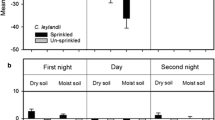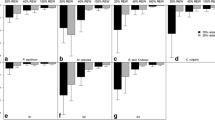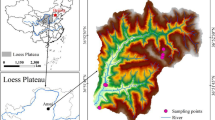Summary
The water relations of Picea abies in a healthy stand with green trees only and a declining stand with trees showing different stages of needle yellowing were investigated in northern Bavaria. The present study is based on observations of trees differing in their nutritional status but apparently green on both sites in order to identify changes in the response pattern which might be caused by atmospheric concentrations of air pollutants and could lead to the phenomenon of decline. Transpiration was measured as water flow through the hydroactive xylem using an equilibrium mass-flow measurement system. Total tree transpiration was monitored diurnally, from July 1985 until October 1985 at both sites. The relationship between transpiration and meteorological measurements indicated that transpiration was a linear function of the vapor pressure deficit. No differences in transpiration of green trees were observed between the two sites. Canopy transpiration was 57%–68% of total throughfall and 41%–54% of total rainfall. Due to this positive water balance, soil water potential at 10 and 20 cm depths remained close to-0.02 MPa (max.-0.09 MPa) for most of the summer. Soil water potential was correlated with the difference between the weekly precipitation and transpiration. No differences in the water relations of apparently healthy trees in the two P. abies stands were observed. It is concluded that differences between green trees at the two sites in terms of nutrient relations or growth rate cannot be explained by changes in whole-tree transpiration or soil water status.
Similar content being viewed by others
References
Čermák J, Kučera J, Penka M (1976a), Improvement of the method of sap flow rate determination in full-grown trees based on heat balance with direct electric heating of xylem. Biol Plant (Praha) 18:105–110
Čermák J, Palat M, Penka M (1976b) Transpiration flow rate in a full-grown tree of Prunus avium L. estimated by the method of heat balance in connection with some meteorological factors. Biol Plant 18:111–118
Čermák J, Huzulak J, Penka M (1980) Water potential and sap flow rate in adult trees with moist and dry soil as used for the assessment of root system depth. Biol Plant 22:34–41
Čermák J, Ulehla J, Kučera J, Penka M (1982) Sap flow rate and transpiration dynamics in the full-grown oak (Quercus robus) L in floodplain forest exposed to seasonal floods as related to potential evapotranspiration and tree dimensions. Biol Plant 24:446–460
Čermák J, Jenik J, Kučera, J, Zidek V (1984) Xylem water flow in a crack willow tree (Salix fragilis L) in relation to diurnal changes of environment. Oecologia 64:145–151
Giles DG, Black TA, Spittlehouse DL (1985) Determination of growing season soil water deficits on a forested slope using water balance analysis. Can J For Res 15:107–114
Hantsćhel R, Kaupenjohann M Horn R, Zech W (1985) Wasserund Elementtransport in unterschiedlich gedüngten, geschädigten Waldökosystemen. Z Deutsch Geol Ges 136:473–480
Kirkby EA, Pilbeam DJ (1984), Calcium as plant nutrient. Plant Cell Envir 7:397–405
McNaughton KG, Jarvis PG (1983) Predicting effects of vegetation changes, on transpiration and evaporation. In: Kozlowski TT (ed) Water deficits and plant growth, vol VII, additional woody crop plants. Academic Press, New York, pp 1–47
Meyer J, Werk KS, Oren R, Zimmermann R, Schulze E-D (1988) Performance of two Picea abies (L) Karst at different stages of decline. V. Root tips and ectomycorrhiza development and their relations to above ground and soil nutrients. Oecologia (in press)
Milne R, Deans JD, Ford ED, Jarvis PG, Leverenz J, Whitehead D (1985) A comparison of two methods of estimating transpiration rates from a Sitka spruce plantation. Boundary-Layer Meteorol 32:155–175
Oren R, Schulze E-D, Werk KD, Meyer J, Schneider BU, Heilmeier H (1988a) Performance of two Picea abies (L) Karst stands at different stages of decline. I. Carbon relations and stand growth. Oecologia 75:25–37
Oren R, Werk KS, Schulze E-D (1986) Relationships between foliage and conducting xylem in Picea abies (L) Karst Trees 1:61–69
Oren R, Werk KS, Schulze E-D, Meyer J, Schneider BU, Schramel P (1988b) Performance of two Picea abies (L) Karst stands at different stages of decline. VI. Nutrient concentrations. Oecologia (in press)
Osonubi O, Oren R, Werk KS, Schulze E-D (1988) Performance of two Picea abies (L) Karst stands at different stages of decline. IV. Xylem sap concentrations of magnesium, calcium, potassium, and nitrogen. Oecologia (in press)
Running S (1984) Microclimate control of forest productivity: Analysis of computer simulation of annual photosynthesis/transpiration balance in different environments. Agriculture and Forest Meteorology 32:2–22
Schulze E-D, Čermák J, Matyssek R, Penka M, Zimmermann R, Vasiček F, Gries W, Kučera J (1985) Canopy transpiration and water fluxes in the xylem of the trunk of Larix and Picea trees — a comparison of xylem flow, porometer and cuvette measurements. Oecologia 66:475–483
Tan CS, Black TA, Nnyamah JU (1978) A simple diffusion model of transpiration applied to a thinned Douglas-fir stand. Ecology 59:1221–1229
Whitehead D, Jarvis PG (1981) Coniferous forests and plantations. In: Kozlowski TT (ed) Water deficits and plant growth, vol VI. Academic Press, New York, pp 49–151
Wight JR, Hanson CL, Cooley KR (1986) Modeling evapotranspiration from Sagebrush-grass rangeland. J Range Manage 39:81–85
Zimmermann R, Oren R, Schulze E-D, Werk KS (1988) Performance of two Picea abies (L) Karst at different stages of decline II. Photosynthesis and leaf conductance. Oecologia 76:513–518
Author information
Authors and Affiliations
Rights and permissions
About this article
Cite this article
Werk, K.S., Oren, R., Schulze, E.D. et al. Performance of two Picea abies (L.) Karst. stands at different stages of decline. Oecologia 76, 519–524 (1988). https://doi.org/10.1007/BF00397863
Received:
Issue Date:
DOI: https://doi.org/10.1007/BF00397863




